Impact of inter-channel interference on shallow underwater acoustic ofdm systems
This paper investigates the impacts of InterChannel Interference (ICI) effects on a shallow underwater acoustic (UWA) orthogonal frequency-Division multiplexing (OFDM) communication system. Considering both the turbulence of the water surface and the roughness of the bottom, a stochastic geometry-based channel model utilized for a wideband transmission scenario has been exploited to derive a simulation model. Since the system bandwidth and the subcarrier spacing is very limited in the range of a few kHz, the channel capacity of a UWA system is severely suffered by the ICI effect. For further investigation, we construct the signal-tonoise-plus-interference ratio (SINR) based on the simulation model, then evaluate the channel capacity. Numerical results show that the various factors of a UWA-OFDM system as subcarriers, bandwidth, and OFDM symbols affect the channel capacity under the different Doppler frequencies. Those observations give hints to select good parameters for UWA-OFDM systems
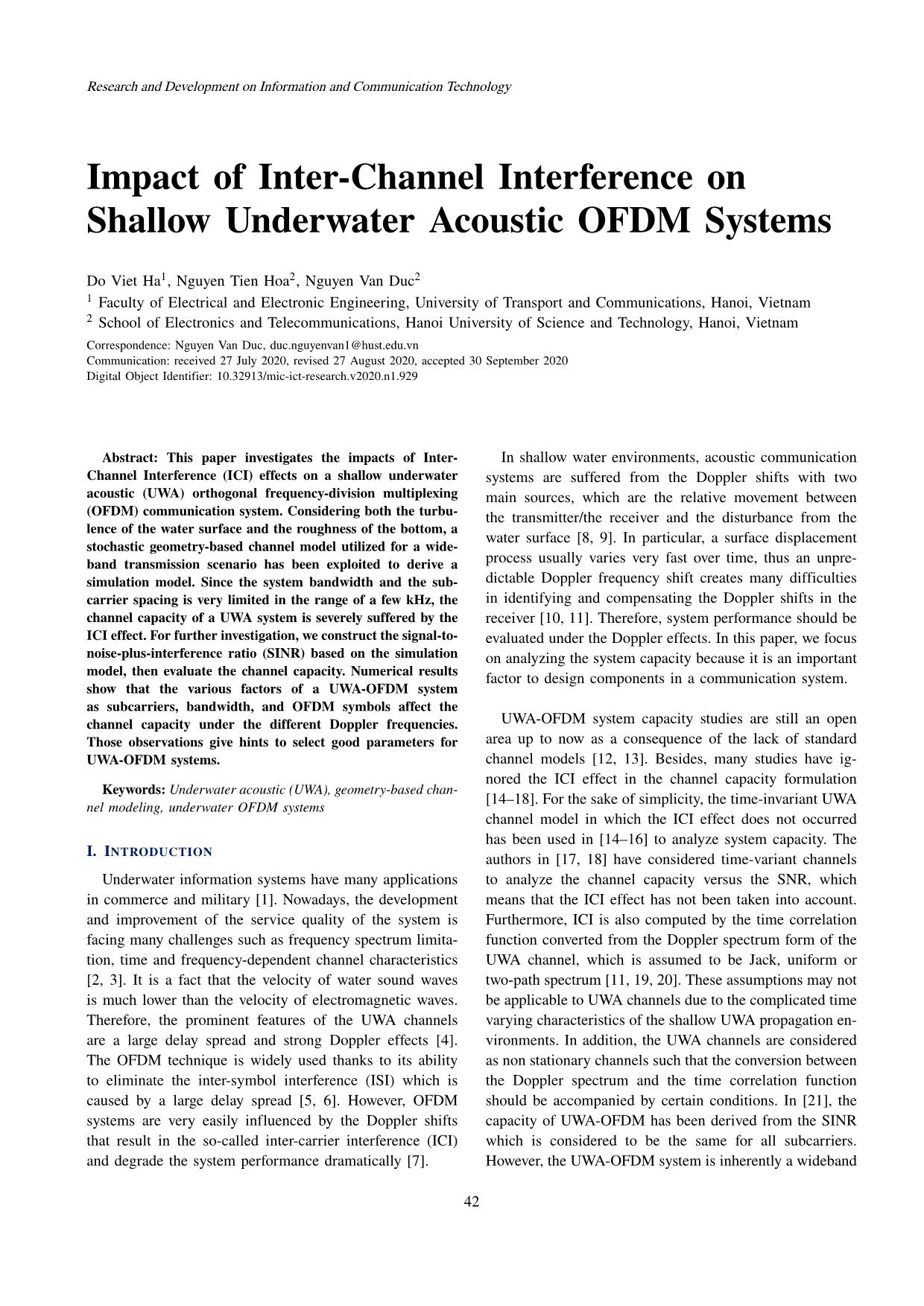
Trang 1
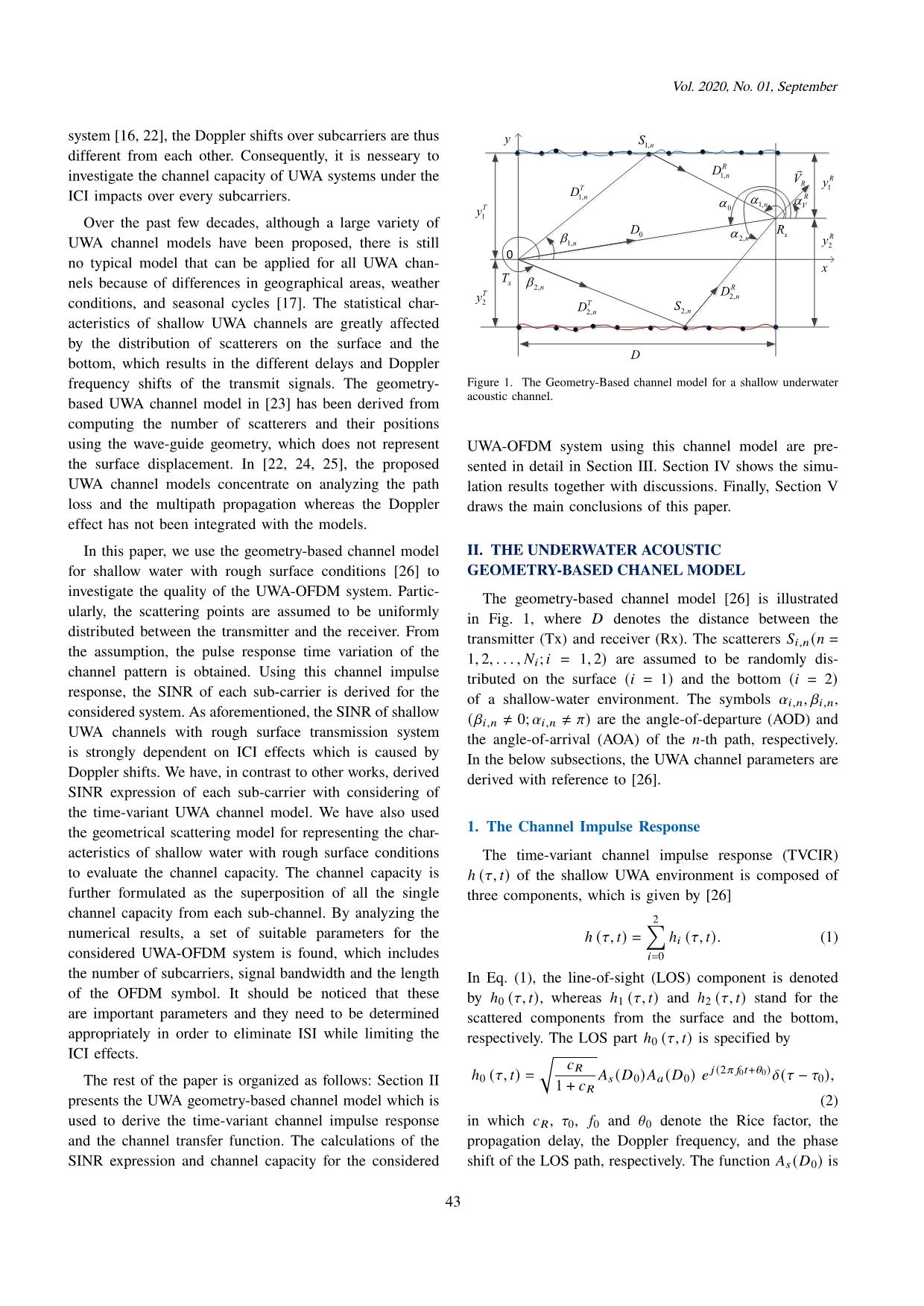
Trang 2
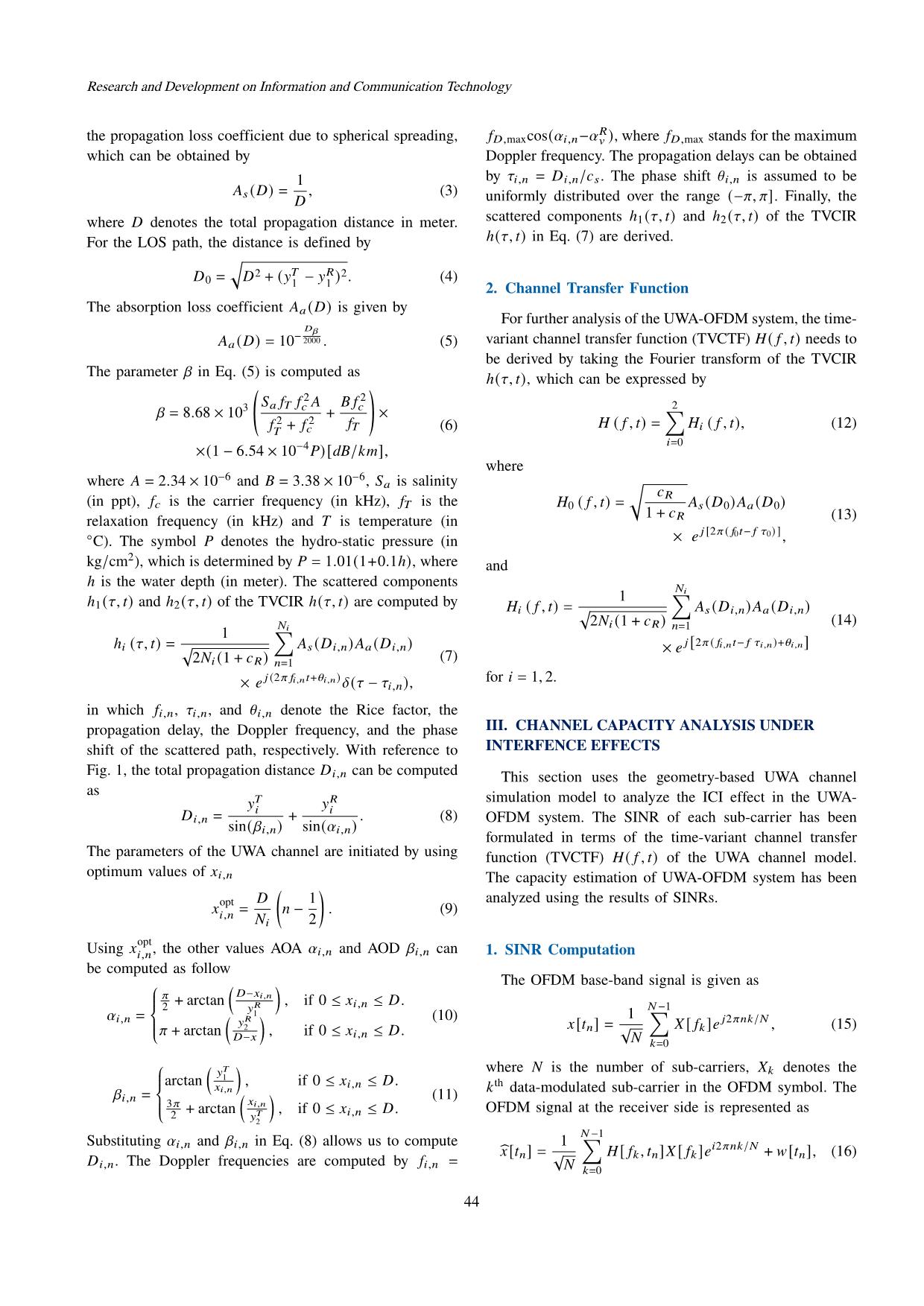
Trang 3
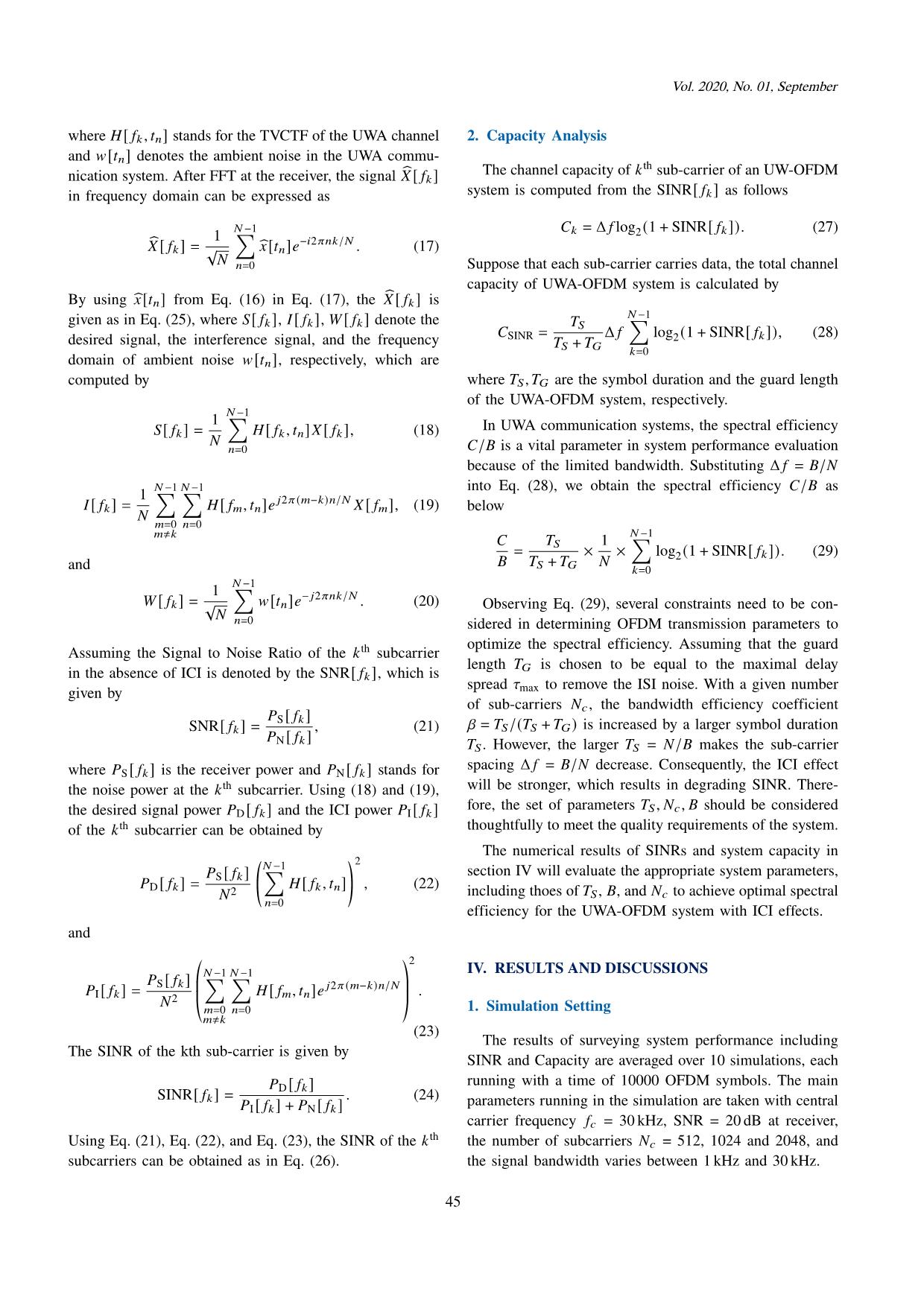
Trang 4
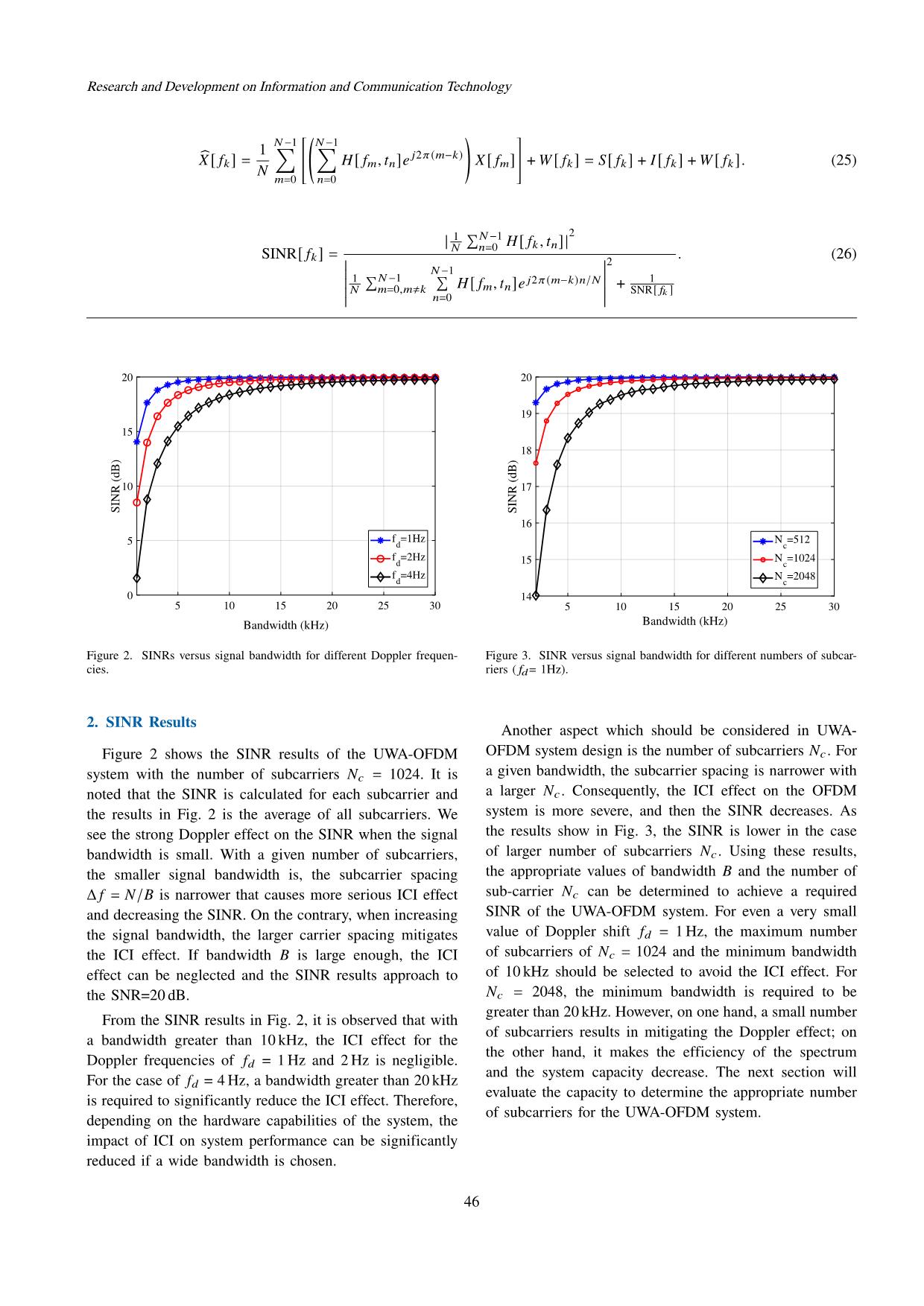
Trang 5
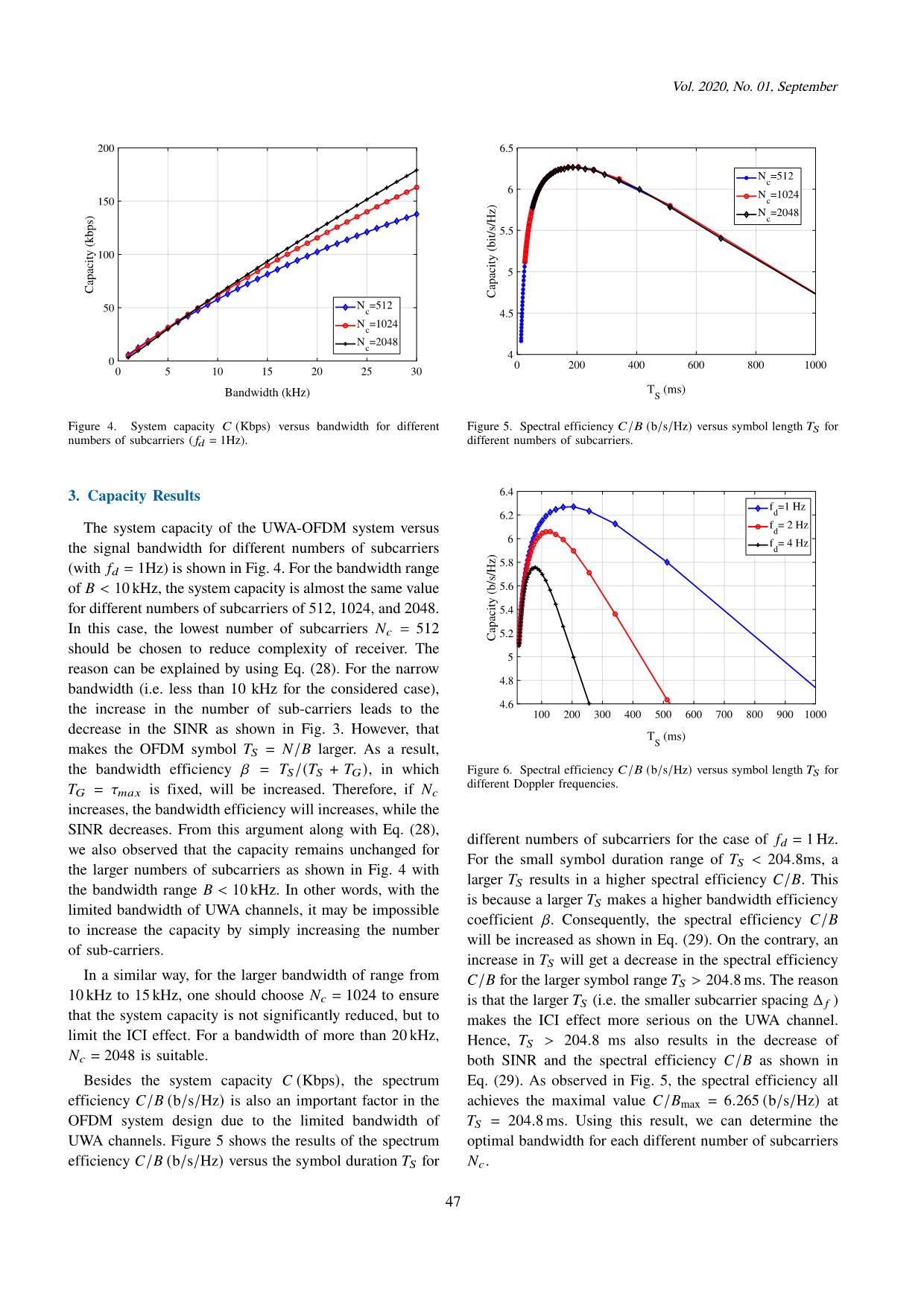
Trang 6
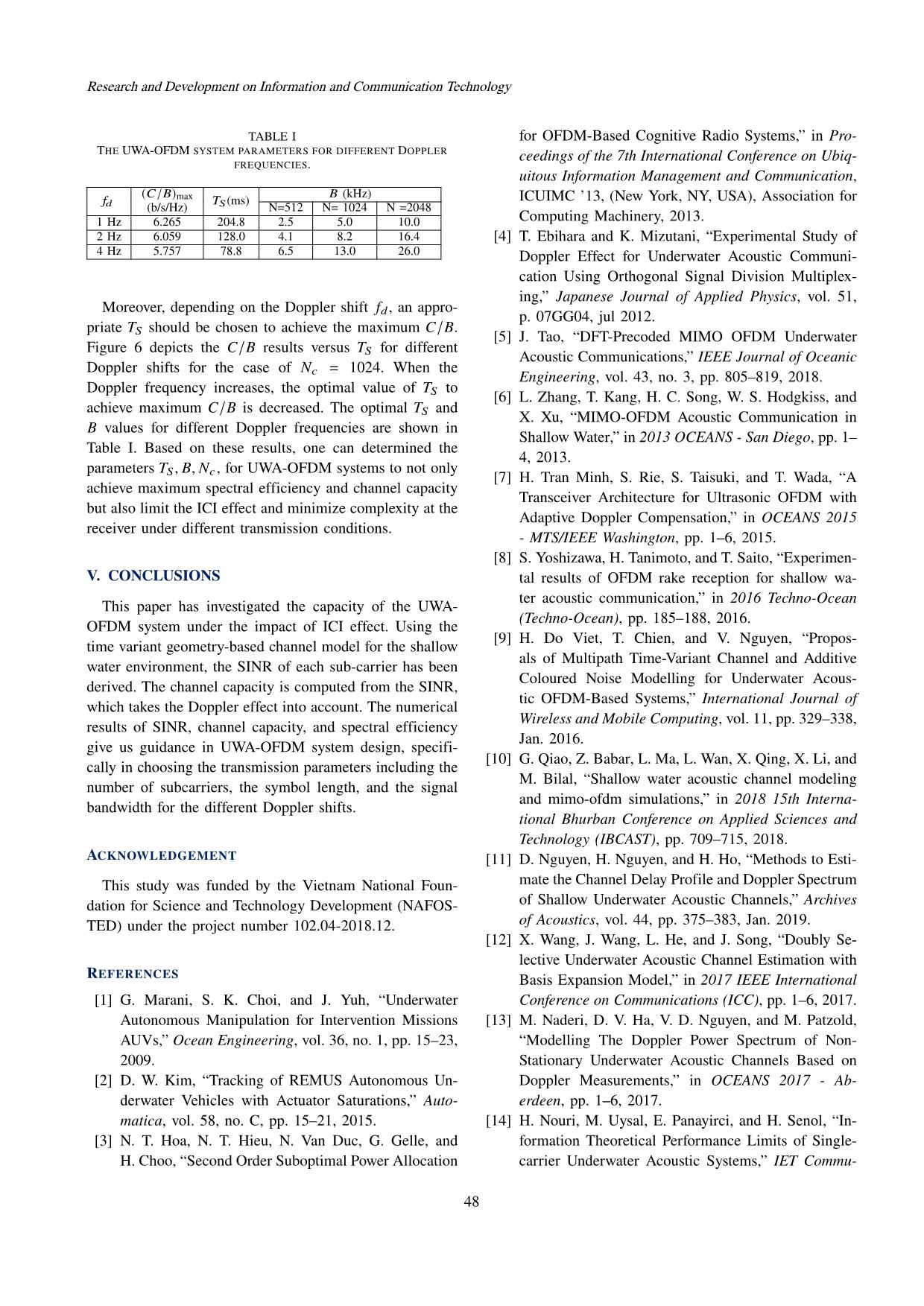
Trang 7
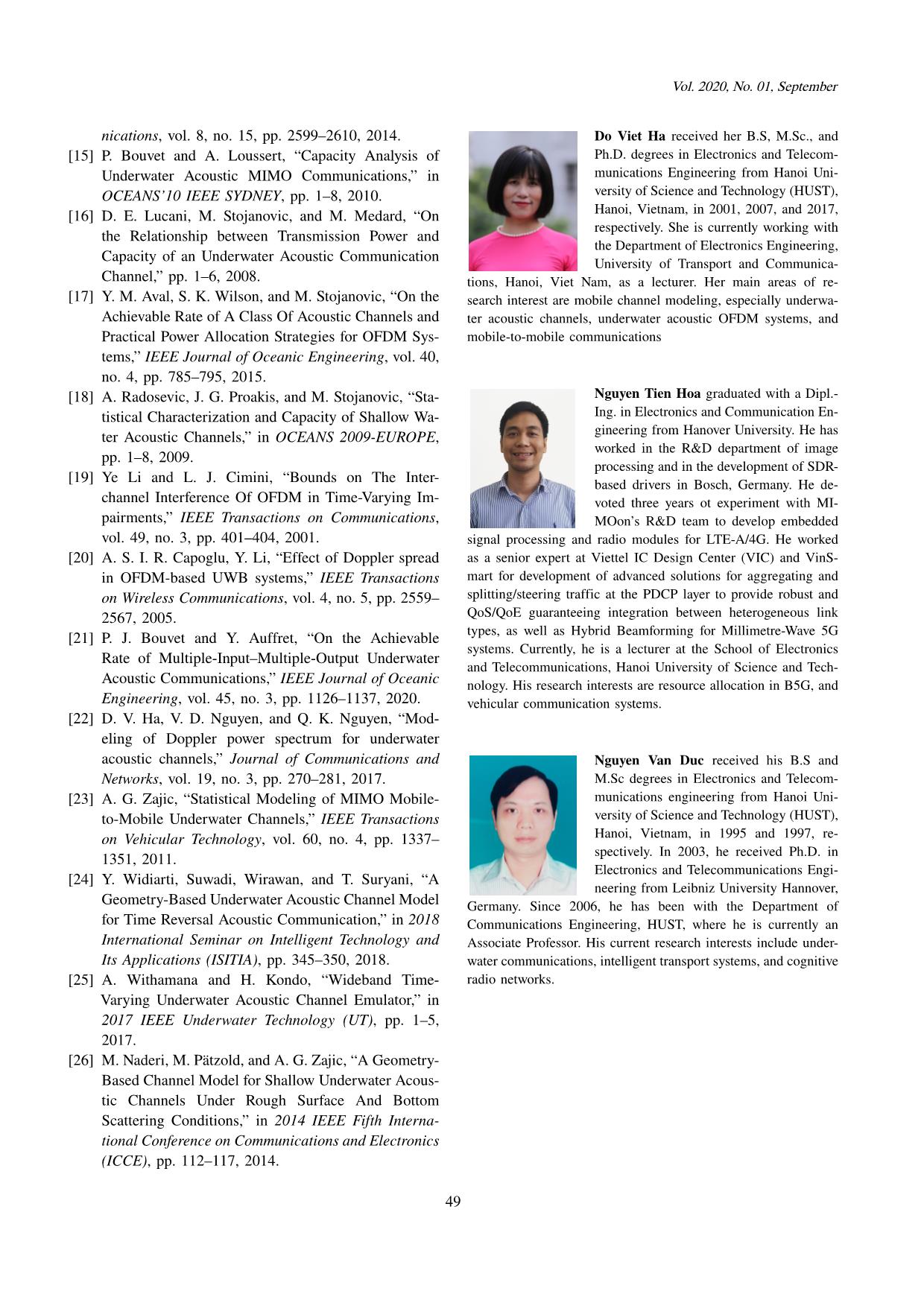
Trang 8
Tóm tắt nội dung tài liệu: Impact of inter-channel interference on shallow underwater acoustic ofdm systems
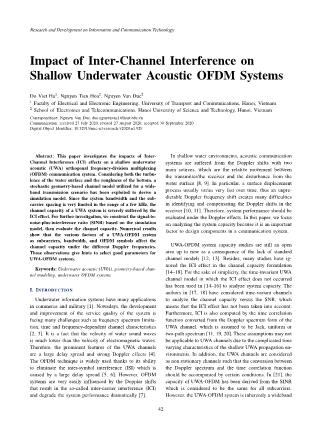
h should be considered in UWA- Figure 2 shows the SINR results of the UWA-OFDM OFDM system design is the number of subcarriers . For system with the number of subcarriers = 1024. It is a given bandwidth, the subcarrier spacing is narrower with noted that the SINR is calculated for each subcarrier and a larger . Consequently, the ICI effect on the OFDM the results in Fig. 2 is the average of all subcarriers. We system is more severe, and then the SINR decreases. As see the strong Doppler effect on the SINR when the signal the results show in Fig. 3, the SINR is lower in the case bandwidth is small. With a given number of subcarriers, of larger number of subcarriers . Using these results, the smaller signal bandwidth is, the subcarrier spacing the appropriate values of bandwidth and the number of Δ = / is narrower that causes more serious ICI effect sub-carrier can be determined to achieve a required and decreasing the SINR. On the contrary, when increasing SINR of the UWA-OFDM system. For even a very small the signal bandwidth, the larger carrier spacing mitigates value of Doppler shift = 1 Hz, the maximum number the ICI effect. If bandwidth is large enough, the ICI of subcarriers of = 1024 and the minimum bandwidth effect can be neglected and the SINR results approach to of 10 kHz should be selected to avoid the ICI effect. For the SNR=20 dB. = 2048, the minimum bandwidth is required to be greater than 20 kHz. However, on one hand, a small number From the SINR results in Fig. 2, it is observed that with of subcarriers results in mitigating the Doppler effect; on a bandwidth greater than 10 kHz, the ICI effect for the the other hand, it makes the efficiency of the spectrum Doppler frequencies of = 1 Hz and 2 Hz is negligible. and the system capacity decrease. The next section will For the case of = 4 Hz, a bandwidth greater than 20 kHz evaluate the capacity to determine the appropriate number is required to significantly reduce the ICI effect. Therefore, of subcarriers for the UWA-OFDM system. depending on the hardware capabilities of the system, the impact of ICI on system performance can be significantly reduced if a wide bandwidth is chosen. 46 Vol. 2020, No. 01, September 200 6.5 N =512 c 6 N =1024 150 c N =2048 c 5.5 100 5 Capacity (kbps) Capacity Capacity (bit/s/Hz) Capacity N =512 50 c 4.5 N =1024 c N =2048 c 4 0 0 200 400 600 800 1000 0 5 10 15 20 25 30 T (ms) Bandwidth (kHz) S Figure 4. System capacity (Kbps) versus bandwidth for different Figure 5. Spectral efficiency / (b/s/Hz) versus symbol length 푆 for numbers of subcarriers ( = 1Hz). different numbers of subcarriers. 3. Capacity Results 6.4 f =1 Hz 6.2 d f = 2 Hz The system capacity of the UWA-OFDM system versus d 6 f = 4 Hz the signal bandwidth for different numbers of subcarriers d 5.8 (with = 1Hz) is shown in Fig. 4. For the bandwidth range of < 10 kHz, the system capacity is almost the same value 5.6 for different numbers of subcarriers of 512, 1024, and 2048. 5.4 In this case, the lowest number of subcarriers = 512 5.2 Capacity (b/s/Hz) Capacity should be chosen to reduce complexity of receiver. The 5 reason can be explained by using Eq. (28). For the narrow 4.8 bandwidth (i.e. less than 10 kHz for the considered case), 4.6 the increase in the number of sub-carriers leads to the 100 200 300 400 500 600 700 800 900 1000 decrease in the SINR as shown in Fig. 3. However, that T (ms) S makes the OFDM symbol 푆 = / larger. As a result, the bandwidth efficiency 훽 = 푆/( 푆 + ), in which Figure 6. Spectral efficiency / (b/s/Hz) versus symbol length 푆 for different Doppler frequencies. = 휏 is fixed, will be increased. Therefore, if increases, the bandwidth efficiency will increases, while the SINR decreases. From this argument along with Eq. (28), different numbers of subcarriers for the case of = 1 Hz. we also observed that the capacity remains unchanged for For the small symbol duration range of < 204.8ms, a the larger numbers of subcarriers as shown in Fig. 4 with 푆 larger results in a higher spectral efficiency / . This the bandwidth range < 10 kHz. In other words, with the 푆 is because a larger makes a higher bandwidth efficiency limited bandwidth of UWA channels, it may be impossible 푆 coefficient 훽. Consequently, the spectral efficiency / to increase the capacity by simply increasing the number will be increased as shown in Eq. (29). On the contrary, an of sub-carriers. increase in 푆 will get a decrease in the spectral efficiency In a similar way, for the larger bandwidth of range from / for the larger symbol range 푆 > 204.8 ms. The reason 10 kHz to 15 kHz, one should choose = 1024 to ensure is that the larger 푆 (i.e. the smaller subcarrier spacing Δ ) that the system capacity is not significantly reduced, but to makes the ICI effect more serious on the UWA channel. limit the ICI effect. For a bandwidth of more than 20 kHz, Hence, 푆 > 204.8 ms also results in the decrease of = 2048 is suitable. both SINR and the spectral efficiency / as shown in Besides the system capacity (Kbps), the spectrum Eq. (29). As observed in Fig. 5, the spectral efficiency all efficiency / (b/s/Hz) is also an important factor in the achieves the maximal value / max = 6.265 (b/s/Hz) at OFDM system design due to the limited bandwidth of 푆 = 204.8 ms. Using this result, we can determine the UWA channels. Figure 5 shows the results of the spectrum optimal bandwidth for each different number of subcarriers efficiency / (b/s/Hz) versus the symbol duration 푆 for . 47 Research and Development on Information and Communication Technology TABLE I for OFDM-Based Cognitive Radio Systems,” in Pro- THE UWA-OFDM SYSTEM PARAMETERS FOR DIFFERENT DOPPLER ceedings of the 7th International Conference on Ubiq- FREQUENCIES. uitous Information Management and Communication, ( / ) (kHz) max (ms) ICUIMC ’13, (New York, NY, USA), Association for (b/s/Hz) 푆 N=512 N= 1024 N =2048 1 Hz 6.265 204.8 2.5 5.0 10.0 Computing Machinery, 2013. 2 Hz 6.059 128.0 4.1 8.2 16.4 [4] T. Ebihara and K. Mizutani, “Experimental Study of 4 Hz 5.757 78.8 6.5 13.0 26.0 Doppler Effect for Underwater Acoustic Communi- cation Using Orthogonal Signal Division Multiplex- ing,” Japanese Journal of Applied Physics, vol. 51, Moreover, depending on the Doppler shift , an appro- p. 07GG04, jul 2012. priate should be chosen to achieve the maximum / . 푆 [5] J. Tao, “DFT-Precoded MIMO OFDM Underwater Figure 6 depicts the / results versus for different 푆 Acoustic Communications,” IEEE Journal of Oceanic Doppler shifts for the case of = 1024. When the Engineering, vol. 43, no. 3, pp. 805–819, 2018. Doppler frequency increases, the optimal value of to 푆 [6] L. Zhang, T. Kang, H. C. Song, W. S. Hodgkiss, and achieve maximum / is decreased. The optimal and 푆 X. Xu, “MIMO-OFDM Acoustic Communication in values for different Doppler frequencies are shown in Shallow Water,” in 2013 OCEANS - San Diego, pp. 1– Table I. Based on these results, one can determined the 4, 2013. parameters , , , for UWA-OFDM systems to not only 푆 [7] H. Tran Minh, S. Rie, S. Taisuki, and T. Wada, “A achieve maximum spectral efficiency and channel capacity Transceiver Architecture for Ultrasonic OFDM with but also limit the ICI effect and minimize complexity at the Adaptive Doppler Compensation,” in OCEANS 2015 receiver under different transmission conditions. - MTS/IEEE Washington, pp. 1–6, 2015. [8] S. Yoshizawa, H. Tanimoto, and T. Saito, “Experimen- V. CONCLUSIONS tal results of OFDM rake reception for shallow wa- ter acoustic communication,” in 2016 Techno-Ocean This paper has investigated the capacity of the UWA- (Techno-Ocean), pp. 185–188, 2016. OFDM system under the impact of ICI effect. Using the [9] H. Do Viet, T. Chien, and V. Nguyen, “Propos- time variant geometry-based channel model for the shallow als of Multipath Time-Variant Channel and Additive water environment, the SINR of each sub-carrier has been Coloured Noise Modelling for Underwater Acous- derived. The channel capacity is computed from the SINR, tic OFDM-Based Systems,” International Journal of which takes the Doppler effect into account. The numerical Wireless and Mobile Computing, vol. 11, pp. 329–338, results of SINR, channel capacity, and spectral efficiency Jan. 2016. give us guidance in UWA-OFDM system design, specifi- [10] G. Qiao, Z. Babar, L. Ma, L. Wan, X. Qing, X. Li, and cally in choosing the transmission parameters including the M. Bilal, “Shallow water acoustic channel modeling number of subcarriers, the symbol length, and the signal and mimo-ofdm simulations,” in 2018 15th Interna- bandwidth for the different Doppler shifts. tional Bhurban Conference on Applied Sciences and Technology (IBCAST), pp. 709–715, 2018. ACKNOWLEDGEMENT [11] D. Nguyen, H. Nguyen, and H. Ho, “Methods to Esti- This study was funded by the Vietnam National Foun- mate the Channel Delay Profile and Doppler Spectrum dation for Science and Technology Development (NAFOS- of Shallow Underwater Acoustic Channels,” Archives TED) under the project number 102.04-2018.12. of Acoustics, vol. 44, pp. 375–383, Jan. 2019. [12] X. Wang, J. Wang, L. He, and J. Song, “Doubly Se- lective Underwater Acoustic Channel Estimation with REFERENCES Basis Expansion Model,” in 2017 IEEE International [1] G. Marani, S. K. Choi, and J. Yuh, “Underwater Conference on Communications (ICC), pp. 1–6, 2017. Autonomous Manipulation for Intervention Missions [13] M. Naderi, D. V. Ha, V. D. Nguyen, and M. Patzold, AUVs,” Ocean Engineering, vol. 36, no. 1, pp. 15–23, “Modelling The Doppler Power Spectrum of Non- 2009. Stationary Underwater Acoustic Channels Based on [2] D. W. Kim, “Tracking of REMUS Autonomous Un- Doppler Measurements,” in OCEANS 2017 - Ab- derwater Vehicles with Actuator Saturations,” Auto- erdeen, pp. 1–6, 2017. matica, vol. 58, no. C, pp. 15–21, 2015. [14] H. Nouri, M. Uysal, E. Panayirci, and H. Senol, “In- [3] N. T. Hoa, N. T. Hieu, N. Van Duc, G. Gelle, and formation Theoretical Performance Limits of Single- H. Choo, “Second Order Suboptimal Power Allocation carrier Underwater Acoustic Systems,” IET Commu- 48 Vol. 2020, No. 01, September nications, vol. 8, no. 15, pp. 2599–2610, 2014. Do Viet Ha received her B.S, M.Sc., and [15] P. Bouvet and A. Loussert, “Capacity Analysis of Ph.D. degrees in Electronics and Telecom- Underwater Acoustic MIMO Communications,” in munications Engineering from Hanoi Uni- OCEANS’10 IEEE SYDNEY, pp. 1–8, 2010. versity of Science and Technology (HUST), [16] D. E. Lucani, M. Stojanovic, and M. Medard, “On Hanoi, Vietnam, in 2001, 2007, and 2017, respectively. She is currently working with the Relationship between Transmission Power and the Department of Electronics Engineering, Capacity of an Underwater Acoustic Communication University of Transport and Communica- Channel,” pp. 1–6, 2008. tions, Hanoi, Viet Nam, as a lecturer. Her main areas of re- [17] Y. M. Aval, S. K. Wilson, and M. Stojanovic, “On the search interest are mobile channel modeling, especially underwa- Achievable Rate of A Class Of Acoustic Channels and ter acoustic channels, underwater acoustic OFDM systems, and Practical Power Allocation Strategies for OFDM Sys- mobile-to-mobile communications tems,” IEEE Journal of Oceanic Engineering, vol. 40, no. 4, pp. 785–795, 2015. [18] A. Radosevic, J. G. Proakis, and M. Stojanovic, “Sta- Nguyen Tien Hoa graduated with a Dipl.- tistical Characterization and Capacity of Shallow Wa- Ing. in Electronics and Communication En- ter Acoustic Channels,” in OCEANS 2009-EUROPE, gineering from Hanover University. He has worked in the R&D department of image pp. 1–8, 2009. processing and in the development of SDR- [19] Ye Li and L. J. Cimini, “Bounds on The Inter- based drivers in Bosch, Germany. He de- channel Interference Of OFDM in Time-Varying Im- voted three years ot experiment with MI- pairments,” IEEE Transactions on Communications, MOon’s R&D team to develop embedded vol. 49, no. 3, pp. 401–404, 2001. signal processing and radio modules for LTE-A/4G. He worked [20] A. S. I. R. Capoglu, Y. Li, “Effect of Doppler spread as a senior expert at Viettel IC Design Center (VIC) and VinS- in OFDM-based UWB systems,” IEEE Transactions mart for development of advanced solutions for aggregating and on Wireless Communications, vol. 4, no. 5, pp. 2559– splitting/steering traffic at the PDCP layer to provide robust and 2567, 2005. QoS/QoE guaranteeing integration between heterogeneous link [21] P. J. Bouvet and Y. Auffret, “On the Achievable types, as well as Hybrid Beamforming for Millimetre-Wave 5G systems. Currently, he is a lecturer at the School of Electronics Rate of Multiple-Input–Multiple-Output Underwater and Telecommunications, Hanoi University of Science and Tech- Acoustic Communications,” IEEE Journal of Oceanic nology. His research interests are resource allocation in B5G, and Engineering, vol. 45, no. 3, pp. 1126–1137, 2020. vehicular communication systems. [22] D. V. Ha, V. D. Nguyen, and Q. K. Nguyen, “Mod- eling of Doppler power spectrum for underwater acoustic channels,” Journal of Communications and Nguyen Van Duc received his B.S and Networks, vol. 19, no. 3, pp. 270–281, 2017. M.Sc degrees in Electronics and Telecom- [23] A. G. Zajic, “Statistical Modeling of MIMO Mobile- munications engineering from Hanoi Uni- to-Mobile Underwater Channels,” IEEE Transactions versity of Science and Technology (HUST), on Vehicular Technology, vol. 60, no. 4, pp. 1337– Hanoi, Vietnam, in 1995 and 1997, re- 1351, 2011. spectively. In 2003, he received Ph.D. in Electronics and Telecommunications Engi- [24] Y. Widiarti, Suwadi, Wirawan, and T. Suryani, “A neering from Leibniz University Hannover, Geometry-Based Underwater Acoustic Channel Model Germany. Since 2006, he has been with the Department of for Time Reversal Acoustic Communication,” in 2018 Communications Engineering, HUST, where he is currently an International Seminar on Intelligent Technology and Associate Professor. His current research interests include under- Its Applications (ISITIA), pp. 345–350, 2018. water communications, intelligent transport systems, and cognitive [25] A. Withamana and H. Kondo, “Wideband Time- radio networks. Varying Underwater Acoustic Channel Emulator,” in 2017 IEEE Underwater Technology (UT), pp. 1–5, 2017. [26] M. Naderi, M. Patzold,¨ and A. G. Zajic, “A Geometry- Based Channel Model for Shallow Underwater Acous- tic Channels Under Rough Surface And Bottom Scattering Conditions,” in 2014 IEEE Fifth Interna- tional Conference on Communications and Electronics (ICCE), pp. 112–117, 2014. 49
File đính kèm:
 impact_of_inter_channel_interference_on_shallow_underwater_a.pdf
impact_of_inter_channel_interference_on_shallow_underwater_a.pdf

